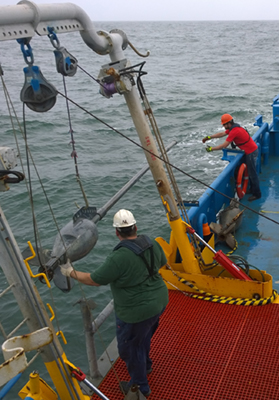The Search for CO2 Storage

Sunrise during active seismic deployment of novel high-resolution 3D seismic equipment (P-Cable) offshore San Luis Pass, 2013. Photo by Dallas Dunlap.

Shallow sediment piston coring above shallow seismic anomalies interpreted from high-resolution 3D seismic data offshore San Luis Pass. Gas analysis successfully tied shallow anomalies to deep-sourced thermogenic gas, validating gas migration pathways interpreted in the seismic data. Photo by Tip Meckel.
Meaningful and rapid reductions in atmospheric CO2 emissions will require capture from industrial sources and deep subsurface injection for utilization and permanent storage. Several remaining technical questions need to be addressed to gain public confidence and reduce deployment barriers. The volume of CO2 that may need to be introduced into the deep subsurface in coming decades could be very large, so we need to address some fundamental research questions.
One question: Do we have enough subsurface space, or capacity, to store this large volume of CO2? Since 2009, research at the Gulf Coast Carbon Center has focused on the importance of offshore Gulf of Mexico injection reservoirs in providing capacity. In 2014, we reported that this offshore region represented some of the most immediately accessible capacity for receiving industrial-scale CO2 emissions, warranting state and national interest. A second study initiated in 2015 continues the characterization effort, focusing on the area of offshore East Texas and westernmost Louisiana, where industrial partnerships are being developed.
Another fundamental question related to subsurface CO2 storage: Will the CO2 stay down there? Given the buoyant nature of CO2 in the subsurface, this is essentially a question of characterizing the geology overlying injection reservoirs (overburden), which has traditionally been of secondary interest for petroleum exploration. Perhaps the most effective tool for continuous subsurface characterization is 3D seismic. Using a grant from the U.S. Department of Energy, we started the first marine high-resolution 3D seismic-acquisition research program in the region, focusing on data acquisition using novel imaging technology to understand subsurface structure, seal continuity, and natural subsurface fluid systems on the inner shelf. Those studies continue today, but the preliminary results are encouraging.
Texas has historically played an instrumental role in national energy policy and development, and its leadership continues. The research being conducted by Dr. Tip Meckel and the team from the Gulf Coast Carbon Center provides the platform of information and data needed to make sound and lasting investments in innovative CO2 management.

Interpreted seismic horizons for two unconformities related to relative sea level change during the Quaternary offshore San Luis Pass. Note fluvial geomorphologies and faults. See Meckel and Mulcahy (2016)* for full interpretation.
*Meckel, T., and Mulcahy, F., 2016, Use of novel high-resolution 3D marine seismic technology to evaluate Quaternary fluvial valley development and geologic controls on shallow gas distribution, inner shelf, Gulf of Mexico: Interpretation, v. 4, no. 1, p. SC35-SC49, http://doi.org/10.1190/INT-2015-0092.1
Project Summary
Project name: Offshore CO2 Storage
Principal information contact: Tip Meckel
Research Program: Gulf Coast Carbon Center and the Center for High-resolution 3D Seismic Imaging
Project start date: 2009, renewed 2015 through September 2018
Project PI(s): Tip Meckel and Ramon Trevino
Key research personnel: Susan Hovorka, Rebecca Smyth, Jiemin Lu, Seyyed Hosseini, Mike Deangelo, Alexander Klokov, Iulia Olariu, David Carr.
Key technologies employed in this research: High-resolution 3D marine seismic imaging system: P-Cable™ technology.
Funding sources and collaborators: U.S. Department of Energy – National Energy Technology Laboratory, Texas General Land Office
Geographic area of study: Inner shelf, western Gulf of Mexico
Keywords: Carbon Capture and Storage, CCS, high-resolution seismic, P-Cable.
Related publications and information resources: Geological CO2 Sequestration Atlas for Miocene Strata Offshore Texas State Waters (in review).